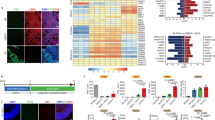Abstract
Ventral mesencephalon (VM) of fetal rat and human origin grown as free-floating roller-tube (FFRT) cultures can survive subsequent grafting to the adult rat striatum. To further explore the functional efficacy of such grafts, embryonic day 13 ventral mesencephalic tissue was grafted either after 7 days in culture or directly as dissociated cell suspensions, and compared with regard to neuronal survival and ability to normalize rotational behavior in adult rats with unilateral 6-hydroxydopamine (6-OHDA) lesions. Other lesioned rats received injections of cell-free medium and served as controls. The amphetamine-induced rotational behavior of all 6-OHDA-lesioned animals was monitored at various time points from 18 days before transplantation and up to 80 days after transplantation. Tyrosine hydroxylase (TH) immunostaining of the histologically processed brains served to assess the long-term survival of grafted dopaminergic neurons and to correlate that with the behavioral effects. Additional cultures and acutely prepared explants were also fixed and stored for histological investigation in order to estimate the loss of dopaminergic neurons in culture and after transplantation. Similar behavioral improvements in terms of significant reductions in amphetamine-induced rotations were observed in rats grafted with FFRT cultures (127%) and rats grafted with cell suspensions (122%), while control animals showed no normalization of rotational behavior. At 84 days after transplantation, there were similar numbers of TH-immunoreactive (TH-ir) neurons in grafts of cultured tissue (775 ± 98, mean ± SEM) and grafts of fresh, dissociated cell suspension (806 ± 105, mean ± SEM). Cell counts in fresh explants, 7-day-old cultures, and grafted cultures revealed a 68.2% loss of TH-ir cells 7 days after explantation, with an additional 23.1% loss after grafting, leaving 8.7% of the original number of TH-ir cells in the intracerebral grafts. This is to be compared with a survival rate of 9.1% for the TH-ir cells in the cell-suspension grafts. Immunostaining for the calcium-binding proteins calretinin, calbindin, and parvalbumin showed no differences in the neuronal expression of these proteins between the two graft types. In conclusion, we found comparable dopaminergic cell survival and functional effects of tissue-culture grafts and cell-suspension grafts, which currently is the type of graft most commonly used for experimental and clinical grafting. In this sense the result is promising for the development of an effective in vitro storage of fetal nigral tissue, which at the same time would allow neuroprotective and neurotrophic treatment prior to intracerebral transplantation.
Similar content being viewed by others
Author information
Authors and Affiliations
Additional information
Received: 11 March 1997 / Accepted: 19 August 1997
Rights and permissions
About this article
Cite this article
Meyer, M., Widmer, H., Wagner, B. et al. Comparison of mesencephalic free-floating tissue culture grafts and cell suspension grafts in the 6-hydroxydopamine-lesioned rat. Exp Brain Res 119, 345–355 (1998). https://doi.org/10.1007/s002210050350
Issue Date:
DOI: https://doi.org/10.1007/s002210050350




